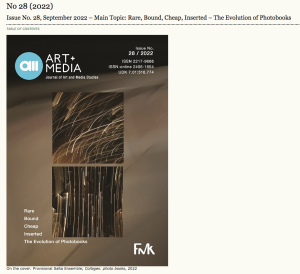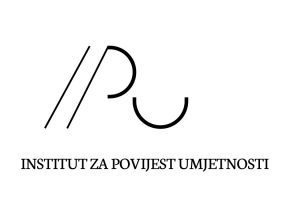The 28th volume of the AM Journal of Art and Media Studies published by the Faculty of Media and Communication of the University of Singidudunum in Belgrade has been published. Theme of the issue – Rare, bound, cheap, inserted – the evolution of photography books. The editor of this edition is Ph.D. Sandra Križić Roban.

From the editorial:
The history of photobooks is closely linked to the history of photography. By shedding light on their evolution, this edition aims to encourage the examination and interpretation of the disparately treated cognitive and visual sequences published in editions over the course of different periods.
Do we accept linearity as an almost indispensable approach to a sequence of images, expecting a potential narrative? How do we interpret the empty gaps and the layout of photographs on the pages? Do we yearn for a verbal text that would clarify the circumstances in which the photos were taken and elucidate their meaning; are we capable of adopting words that function as an additional form of the image, which are impossible to visualize in a way other than through language? Are photobooks “expanded photo-essays” (Parr, Bedger), and to what extent, in order to understand the medium, do we have to consider typography, the choice of paper and other elements of design? Is the institutionalization of photobooks favorable; does digitization increase their visibility, or does it take away relevant aspects that are impossible to access while looking at a screen? What are the differences between books with photographic illustrations and recently created ones that defy existing classifications? Have women conceived a different form of photobooks, and, if so, what are their peculiarities?
Hand-made books created outside of the standard Western artistic canon, which are often found within the practice of “artist’s books” in Central, Eastern and Southeast Europe, exemplify conceptual strategies often incompatible with standard narratives. Moreover, their content is often directed at the complex political circumstances, reacting to the ideological discourse in different ways, depending on the political and social situations, which, in this vast geopolitical area differ significantly from the rest of the world. Sometimes they contain parts written in by hand, while other editions reveal archaeological traces of sorts – objects that address the nature of the medium and its history.
In recently published photobooks, photographs are often laid out in a way that they partly extend to the next page, making the viewing more difficult and setting new challenges before the viewers. Traditional hierarchies are abandoned, the content is no longer necessarily bound within the book but simply inserted, surrendered to rearranging by the observer. Photobooks increasingly become hybrids between the printed medium and sculptural objects, arranged spatially in a completely arbitrary way that might be reminiscent, for instance, of Petar Dabac’s Cube. Books become a game, an intellectual enticement for the re-examination of established structures and finding ways of working outside set formats and editorial decisions.
Photobooks have become more akin to artist’s books. Therefore, we propose an investigation – of the chronological development, geographical, historical, cultural, and other aspects, as well as the contemporary divergences from previous stylistic and formal standards – as the focus of the 28th issue of the AM Journal of Art and Media Studies.
Content:
https://fmkjournals.fmk.edu.rs/index.php/AM/issue/view/31/showToc


